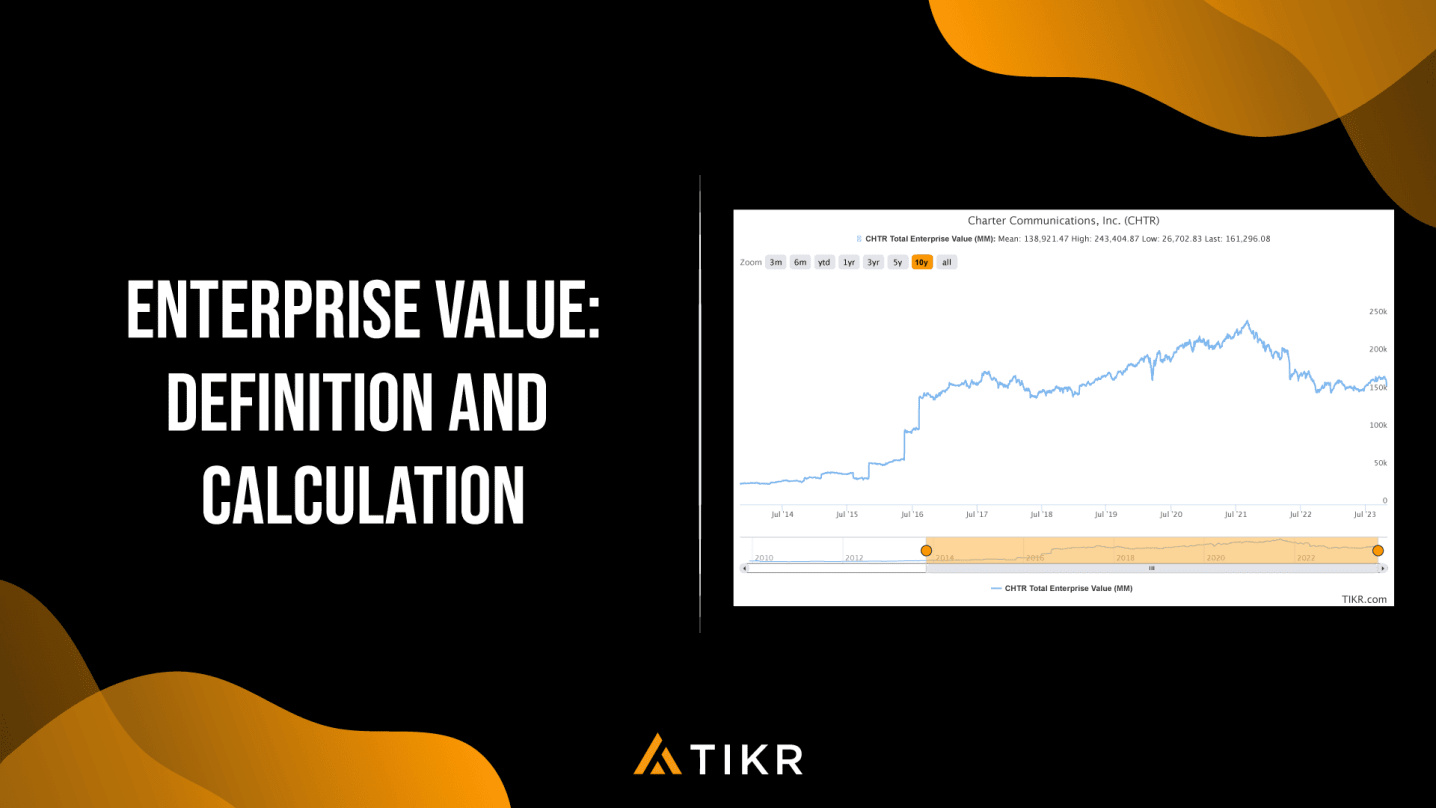Enterprise value (EV) is a financial metric that offers a comprehensive snapshot of a company’s total value. Unlike market capitalization which solely accounts for a company’s equity value, enterprise value factors in the firm’s entire capital structure such as its debt, cash, preferred equity, and minority interest.
By doing so, EV provides investors, analysts, and business owners with a comprehensive perspective of a company’s financial worth, facilitating more informed decision-making in investment, valuation, and M&A activities.
Breaking Down the Enterprise Value Formula
The enterprise value formula is calculated as follows:
EV = Market Capitalization + Total Debt − Cash and Cash Equivalents + Preferred equity + Minority Interest
- Market capitalization represents the total value of a company’s outstanding shares of common equity. It is calculated by multiplying the company’s share price by its total outstanding shares
- Total debt incorporates all of the company’s short-term and long-term debt obligations
- Cash and cash equivalents are liquid assets a company holds that are unrestricted cash assets on the balance sheet
- Preferred equity is senior to the common equity and is an additional claimholder that is accounted for in the Enterprise Value calculation. Dividends to preferred shareholders are paid first before the common stock equity holders receive any dividends
- Minority Interest represents a partial ownership stake of below 50% in a company. It generally shows up on the balance sheet as a non-controlling interest
Interpreting Enterprise Value in Business Valuation
Enterprise value is popular among analysts as it considers everything owned and owed by a company and provides a holistic financial picture. The EV metric can be used for:
Investment Analysis: EV helps compare companies with varying debt structures and cash positions. It provides a clear picture of a firm’s underlying value, making it a preferred metric for assessing investment prospects.
Mergers and Acquisitions: In the realm of M&A, buyers and investors leverage EV to estimate the total takeover value of a company. It outlines the complete cost implication of an acquisition, offering pivotal insights for negotiation and decision-making.
Risk Assessment: By factoring in debt, EV also aids in evaluating a company’s financial risk. A higher debt component can indicate increased financial risk, while ample cash reserves suggest financial flexibility.
How is EV used as a valuation multiple?
Enterprise value is a foundational element for various financial ratios that assess a company’s performance.
When using valuation multiples for assessing a company’s worth, it’s important that the top and bottom numbers in the ratio (numerator and denominator) correspond correctly. If you’re using Enterprise Value as the numerator, then the denominator, which represents the company’s earning power, should reflect an amount available to all claimholders. Examples of metrics that can be used in the denominator include revenue, EBITDA, or EBIT.
One example is the EV/EBITDA multiple, which compares a company’s total enterprise value to its operating earnings as encapsulated by EBITDA.
EV/EBITDA
The EV/EBITDA is instrumental for analysts and investors to evaluate and compare companies within similar sectors.
EBITDA is useful as a financial metric as it provides a way to assess a company’s operational performance independent of its capital structure and financing decisions. By excluding interest expense, EBITDA removes the effects of different debt levels across companies, making it a capital structure-neutral measure.
However, EBITDA has notable downsides. One major drawback is that it doesn’t account for differences in capital expenditures (CapEx) between companies. CapEx, the funds used by a company to acquire or upgrade physical assets such as property, industrial buildings, or equipment, can significantly affect the cash flow and financial health of a company.
Since EBITDA excludes these expenses, it might give an inflated view of a company’s available cash and its operational efficiency.
Conclusion
Enterprise Value (EV) is a crucial metric that offers a comprehensive view of a company’s total value, including debt and cash reserves. While EV is a valuable tool, it’s essential to consider its complexities and use it alongside other financial indicators for a balanced view.
EV’s true strength emerges when applied with discernment, providing investors with nuanced insights to make informed investment decisions, especially when comparing companies within the same industry.
TIKR calculates Enterprise Value for 100,000+ companies globally. Get started on TIKR.com for free today!





